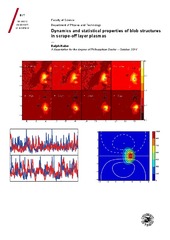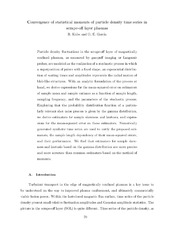| dc.contributor.advisor | Garcia, Odd Erik | |
| dc.contributor.author | Kube, Ralph | |
| dc.date.accessioned | 2015-02-04T09:27:40Z | |
| dc.date.available | 2015-02-04T09:27:40Z | |
| dc.date.issued | 2014-12-16 | |
| dc.description.abstract | The velocity scaling of blobs, subject to dissipation by either electric currents to the sheaths, or dynamical friction, is studied by numerical simulations where the blob amplitude relative to the background plasma is a free parameter. When subject to dissipation by sheath currents, the radial velocity of a blob depends on the square of its cross field size l, vrad ∼ √l for small l. For large l, the radial velocity of the blob scales as vrad ∼ l−2. The radial blob velocity is maximal for an intermediate size and depends sensitively on the blob amplitude relative to the background density. In the case of dynamical friction, the blob velocity depends on its cross field size as vrad ∼ √l when friction is negligible. For strong friction the blob velocity is inversely proportional to the friction coefficient and size independent. The length scale for the transition between these velocity regimes depends sensitively on the relative blob amplitude.
An algorithm to track plasma blobs in spatially resolved optical measurements is developed and applied to gas-puff imaging data obtained from the scrape-off layer of the Alcator C-Mod tokamak. For discharges where the line averaged plasma density is small relative to the Greenwald density, ne/nG ≾ 0.3, the observed radial blob velocities are well approximated by the sheath connected velocity scaling. In the case of ne/nG ≾ 0.4, the radial blob velocities are found to be larger than predictions by the sheath connected velocity scaling.
Statistical properties of the scrape-off layer plasma in Alcator C-Mod are studied for a series of discharges where the line-averaged particle density was varied. Long time series of the ion saturation current and the floating potential are obtained from Langmuir probes dwelled in the outboard mid- plane scrape-off layer as well as from a set of Langmuir probes embedded in the lower divertor baffle. We find that the waiting times between burst events and the burst amplitudes are approximately exponentially distributed. The exponentially distributed burst waiting times are compatible with the assumption that the individual blob events are uncorrelated. The conditionally averaged burst shapes of the saturation current perturbations and floating potential are similar for both poloidal positions at low line-averaged particle densities. For a discharge with high line-averaged density we find that the electric potential, sampled at the divertor, looses coherence with increasing distance to the last closed flux surface. These results indicate that sheath dissipation is a robust mechanism that governs the dynamics of plasma blobs in Alcator C-Mod at low line-averaged particle densities, while at high densities the blob filaments are electrically disconnect from the sheaths. | en |
| dc.description.doctoraltype | ph.d. | en |
| dc.description.popularabstract | Nuclear Fusion is a viable alternative for the sustainable production of large
amounts of energy with abundant fuel. This thesis presents a study of the dynamics and
statistical properties of blob struc- tures in scrape-off layer plasmas. The scrape-off
layer is the outermost shell of a plasma magnetically confined in toroidal geometry, as
one might use to sustain nuclear fusion re- actions and blobs are a mode, by which
particles and heat are transported through this layer. The dynamics are studied by
numerical simulation of seeded plasma blobs subject to dissipation mechanisms that
are believed to be relevant in fusion relevant plasmas. We find that the radial velocity
of the plasma blobs depends, among others, on its cross-field size and initial amplitude
relative to the background plasma. Analyzing optical measurements made in the scrape-off
layer of the Alcator C-Mod tokamak, we find that the theoretically found velocity scaling
is compatible with the velocities found in experiments.
Fluctuation statistics of the plasma parameters, observed in several positions in the
scrape-off layer of Alcator C-Mod are studied and compared to several prevalent statistical
models. We find that none of them can be discarded. The averaged waveform observed of
the measured time series is compatible with the radial motion of blob-like structures.
With increasing line-averaged particle density, we observe features compatible with
the a dissipation mechanism that was studied numerically. | en |
| dc.description | Paper 3 of this thesis is not available in Munin:<br> 3. R. Kube, O. E. Garcia, B. LaBombard, J. L. Terry and S. J. Zweben: ‘Blob sizes and velocities in the alcator C-MOD scrape-off layer’. Journal of Nuclear Materials, 2013, 438, S505-S508. Available at <a href=http://dx.doi.org/10.1016/j.jnucmat.2013.01.104>http://dx.doi.org/10.1016/j.jnucmat.2013.01.104</a> | en |
| dc.identifier.uri | https://hdl.handle.net/10037/7088 | |
| dc.identifier.urn | URN:NBN:no-uit_munin_6678 | |
| dc.language.iso | eng | en |
| dc.publisher | UiT Norges arktiske universitet | en |
| dc.publisher | UiT The Arctic University of Norway | en |
| dc.rights.accessRights | openAccess | |
| dc.rights.holder | Copyright 2014 The Author(s) | |
| dc.rights.uri | https://creativecommons.org/licenses/by-nc-sa/3.0 | en_US |
| dc.rights | Attribution-NonCommercial-ShareAlike 3.0 Unported (CC BY-NC-SA 3.0) | en_US |
| dc.subject | VDP::Mathematics and natural science: 400::Physics: 430::Space and plasma physics: 437 | en |
| dc.subject | VDP::Matematikk og Naturvitenskap: 400::Fysikk: 430::Rom- og plasmafysikk: 437 | en |
| dc.title | Dynamics and statistical properties of blob structures in scrape-off layer plasmas | en |
| dc.type | Doctoral thesis | en |
| dc.type | Doktorgradsavhandling | en |


 English
English norsk
norsk




